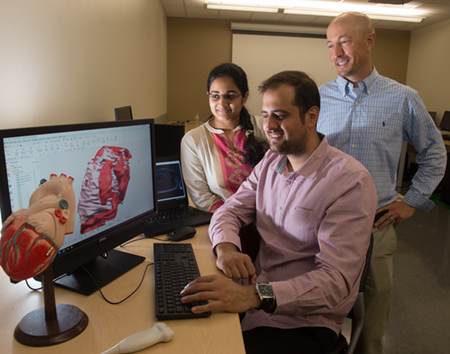 Heart disease is the leading cause of the death in the United States, and current technologies used to measure risk are expensive and often inaccessible. That’s why Southern Illinois University Edwardsville researchers are working to create a more cost-effective tool for identifying risk of cardiac events through the innovative use of ultrasound.
Heart disease is the leading cause of the death in the United States, and current technologies used to measure risk are expensive and often inaccessible. That’s why Southern Illinois University Edwardsville researchers are working to create a more cost-effective tool for identifying risk of cardiac events through the innovative use of ultrasound.
The American Heart Association has granted SIUE $154,000 in support of the research being conducted by principal investigator Jon Klingensmith, PhD, assistant professor in the School of Engineering’s Department of Electrical and Computer Engineering. Klingensmith’s primary background is in ultrasound signal processing and coronary imaging.
Closely collaborating on the project is Maria Fernandez-del-Valle, PhD, an expert on obesity and the use of intervention to affect the deposits of fat around internal organs. Fernandez-del-Valle is an assistant professor of exercise science in the School of Education, Health and Human Behavior’s Department of Applied Health. Also contributing to the research with his 3D modeling expertise is H. Felix Lee, professor of industrial engineering at SIUE.
According to the researchers, magnetic resonance imaging (MRI) has emerged as the primary tool for precise body fat measurement, but it is expensive, time-consuming and not widely available. Echocardiography, they say, is safe, real-time, inexpensive (relative to MRI), and can be used to quantify cardiac structure and function.
The research team proposes the two can be powerfully combined to create a new, innovative tool for analysis. Three-dimensional modeling will be used on previously acquired MRI data. The cardiac fat tissue, however, will be identified with ultrasound and then merged with the 3D model to create a volume measurement.
“We are creating a software-based tool that provides specific volume measurements of the cardiac adipose tissue (EAT) based only on echocardiographic ultrasound imaging that will facilitate and accelerate future studies on obesity and cardiovascular disease,” said Klingensmith.
“This technology would be more accessible and less expensive than current approaches, and could make measurement of cardiac fat a standard diagnostic test for risk of heart attack,” he added. “In addition, it could provide meaningful tracking of overall cardiovascular health in the treatment of obese and overweight patients. This would provide insight into progress or improvement in health in response to dietary or lifestyle intervention, independent of body mass or shape.”
The novel model could be used not only in hospitals, but also weight loss clinics and other facilities with properly trained personnel.
“We know that excessive fat around the heart has been linked to the development of cardiovascular disease,” Fernandez-del-Valle explained. “This volumetric model will be useful to not only assess the effects of different types of exercise, but also other strategies such as diet, drugs, bariatric surgery and more.
“With regard to applied research in exercise, the impact of this project is significant, as results could have the potential to change exercise recommendations for weight and fat loss, cardiovascular risk management and cardiac heath.”
SIUE graduate students are playing an integral role in the research, including master’s candidates Saygin Sop, of Izmir, Turkey, who is studying industrial engineering, along with Akhila Karlapalem, of Hyderabad, India, and Addison Elliot, of Springfield, both of whom are studying electrical engineering.
Additionally, eight undergraduates are contributing to the research. Three of the students are participating through SIUE’s Undergraduate Research and Creativity Activities (URCA) program, including engineering majors Miranda Fulton, of Staunton, Zechariah Faszold, of Belleville, and Taylor David, of Collinsville. Others pursuing studies in the health sciences, will gain valuable hands-on experience by voluntarily contributing to the research.
“I’ll be using ultrasound images to analyze the frequency spectrum of the adipose tissues, and identifying or differentiating between adipose tissue and the heart,” explained Karlapalem, regarding her role in the project. “When I was young, I lost my uncle to a heart attack. I was interested in this project, because I thought if I assist in the research, maybe I can help people reduce the risk of cardiac events.”
“3D modeling interests me, so I am glad to work on this project, and gain research and field experience,” added Sop.
“This is a unique opportunity for students that will enhance their academic experience,” Klingensmith said. “By being involved in this interdisciplinary work, our student researchers will participate in an applied learning setting, and gain opportunities to establish a network by making corporate connections and develop interpersonal skills.”
Photo: Graduate student Saygin Sop (seated) looks at a 3D model with fellow student Akhila Karlapalem, while Dr. Jon Klingensmith looks on.